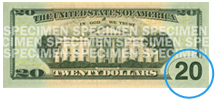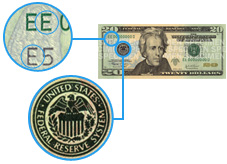A safer, smarter and more secure $20 bill began circulating October 9, 2003, as part of the United States government's ongoing effort to stay ahead of counterfeiting and maintain worldwide confidence and trust in United States currency. The redesigned $20 bill was the first denomination to incorporate enhanced security features and subtle background colors into the design.
Security Features
The redesigned $20 bills are safer, smarter and more secure: safer because they're harder to fake and easier to check; smarter to stay ahead of tech-savvy counterfeiters; more secure to protect the integrity of United States currency. Because these features are difficult for counterfeiters to reproduce well, they often do not try, hoping that cash handlers and the public will not check their money.
Color-Shifting Ink

Tilt your bill to see if the numeral 20 in the lower right corner on the front of the bill changes color from copper to green. The color shift is more dramatic in the redesigned currency, making it easier for people to check their money.
Watermark

Hold the bill to light and look for the watermark, or faint image, similar to the large portrait. The watermark is part of the paper itself and can be seen from both sides of the bill.
Security Thread

Hold the bill to light and look for the security thread that is embedded in the paper and runs vertically up one side of the bill. If you look closely, the words USA TWENTY and a small flag are visible along the thread from both sides of the bill. The security thread glows green when illuminated by ultraviolet light.
Additional Design and Security Features
The redesigned currency remains the same size and uses the same, but enhanced portraits and historical images as the older-design bills, and importantly, continues to be recognized around the world as quintessentially American.
Symbols of Freedom

Appearing on the front of the bill are two American eagle symbols of freedom. The large blue eagle in the background to the left of President Andrew Jackson's portrait is representative of those drawn and sculpted during his time period. The smaller green metallic eagle to the lower right of the portrait is a more contemporary illustration, using the same raised ink intaglio process as the portrait, numerals and engravings. The symbols of freedom differ for each denomination.
Color
The most noticeable difference in the redesigned $20 bill is the addition of subtle background colors of green, peach and blue to both sides of the bill. This marked the first time in modern American history that U.S. currency included colors other than black and green. The words TWENTY USA are printed in blue in the background to the right of the portrait. The background colors add complexity to the bills and differ with each denomination to help distinguish them. Because color can be duplicated by potential counterfeiters, it should not be used to verify the authenticity of the bill.
Updated Portrait and Vignette

The oval borders and fine lines surrounding the portrait of President Jackson on the front, and the White House vignette on the back, have been removed. The portrait has been moved up and shoulders have been extended into the border. Additional engraving details have been added to the vignette background.
Microprinting

Because they are so small, microprinted words are hard to replicate. The redesigned $20 bill features microprinting on the front of the bill in two areas: bordering the first three letters of the TWENTY USA ribbon to the right of the portrait, the inscription USA20 is printed in blue. THE UNITED STATES OF AMERICA 20 USA 20 appears in black on the border below the Treasurer's signature..
Low-Vision Feature

The numeral 20 in the lower right corner on the back of the bill is enlarged to help those with visual impairments distinguish the denomination.
Federal Reserve Indicators

A universal seal to the left of the portrait represents the entire Federal Reserve System. A letter and number beneath the left serial number identifies the issuing Federal Reserve Bank. There are 12 regional Federal Reserve Banks and 24 branches located in major cities throughout the United States.
Serial Numbers

The unique combination of eleven numbers and letters appears twice on the front of the bill. Because they are unique identifiers, serial numbers help law enforcement identify counterfeit notes, and they also help the Bureau of Engraving and Printing track quality standards for the notes they produce.
